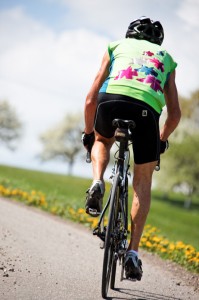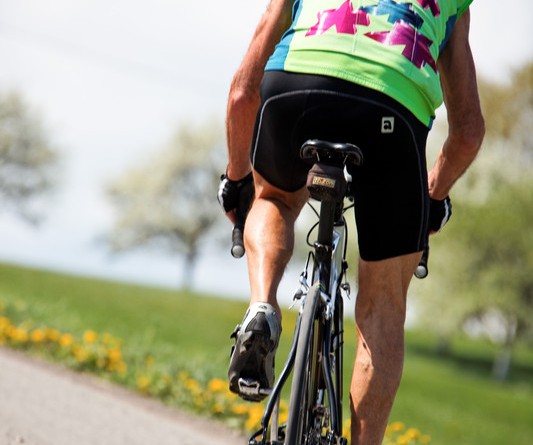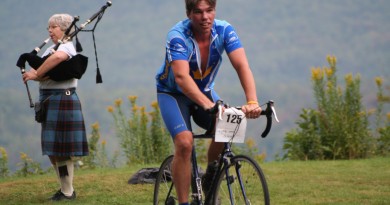Taking Sides | How Vermont Motorists and Cyclists Are Sharing the Road—Or Are They?
 You’ve heard the stories. Or maybe you’ve experienced them firsthand. Flipped birds, coffee cups, beer cans. Drivers pulling alongside to say something clever, or something dumb. A pickup truck clipping your shoulder with the side mirror.
You’ve heard the stories. Or maybe you’ve experienced them firsthand. Flipped birds, coffee cups, beer cans. Drivers pulling alongside to say something clever, or something dumb. A pickup truck clipping your shoulder with the side mirror.
But wait, what’s that Lycra-clad twosome on their $1,000 bikes doing hogging the road? Running a stop sign? Failing to signal before turning? Some town police, you hear, are doling out $200 fines and license points to bad-behaving cyclists: good.
Whichever you are—bicyclist, motorist, probably both—you know that things can get nasty out on the streets, even streets as bucolic as those in a state known for its bicycle tours. Vermont is still divided when it comes to “Share the Road” initiatives and the subject of cyclist safety. While the crash statistics have remained steady in the past decade, according to Jon Kaplan, the bicycle and pedestrian program manager for the Vermont Agency of Transportation, the tension seems to be rising steeper than a Green Mountain grade for plenty of two-wheelers and four-wheelers alike.
“Riding this morning,” one friend told me, “I wished I had a sign on my back that said: ‘My life is as precious as your time. Please don’t hit me.’”
Nationally, the numbers point to better awareness between motorists and bicyclists: according to the National Highway Traffic Safety Administration and the University of North Carolina–based Pedestrian and Bicycle Information Center, there were 52,000 bicyclist injuries in 2010, compared with 61,000 in 1995. In Vermont, Kaplan reports that there have been about 250 crashes between cars and bicyclists or cars and pedestrians each year since 2003. But researchers also reveal that the vast majority of injury-causing bicycle crashes—as much as 90 percent—aren’t recorded by police.
Eliminating those crashes altogether, and keeping motorists and bicyclists equally happy, requires a multipronged approach of education, awareness, and road improvements. “It’s a constant ebb and flow of good news and not-so-good news,” Nancy Schulz, the executive director for the Vermont Bicycle & Pedestrian Coalition, “and you just keep hoping that the balance is going to shift.”
Among the good news that Schulz cites is the work of Local Motion to improve the Burlington Bike Path and provide regular bike-ferry service connecting the Lake Champlain Islands. Among the not-so-good news: not only “stasis,” such as with the bike routes around Montpelier and Barre, but also Tropical Storm Irene, which screwed up efforts to make Vermont streets safe for all users, as dictated by the Complete Streets bill signed by Gov. Peter Shumlin in May 2011. “The need was to get the roads open, to get the bridges back as soon as possible,” says Schulz, “so Complete Streets wasn’t followed.”
Even if every road had a two-foot paved shoulder (“We would be in cycling heaven,” says Schulz), something else is now sharing the road with drivers and cyclists: technology and myriad other distractions made possible by the car-as-second-home culture. Eric Darling, who commutes from Shelburne to work in Colchester, has noticed that whenever he has a near-miss with a motorist, more often than not the driver is using a cell phone. He’s seen drivers holding the phone with one hand while gesturing, smoking, or brushing their hair with the other; one motorist was holding a plate of food up to his face with one hand while shoveling the food into his mouth with the other hand. “There seems to be more awareness of cyclists on the road, but I’m not sure that has translated into safer riding,” he says. “If anything, I feel less safe riding my bike each year.”
For their part, some cyclists are using technology to fight back, recording driver infractions with cell-phone videos or helmet cams. As The New York Times reported in July, these videos are now becoming crucial pieces of evidence in police investigations and lawsuits.
Of course, whipping out your iPhone while riding may not be the safest choice either, and there are plenty of infractions by cyclists too. “I know there are behavioral problems,” says Schulz, adding that her coalition created a “bad bicycle behavior report” to handle complaints from drivers.
From analyzing six years’ worth of bicycle crash data, Kaplan says that the top things that bicyclists do wrong are “improper crossing and darting,” riding the wrong way on the road, and failing to yield the right of way.
You can talk about right and wrong, and you can talk to Rose Long, a former University of Vermont cyclist who suffered facial trauma, dental trauma, a broken thumb, and a collapsed lung when she was hit by a Jeep in Burlington in September 2008. “Cyclists always lose when it comes to bike versus car,” says Long, who says that while she felt very supported by the people of Burlington and Vermont, she has since left the state and views the Queen City as a place that remains dangerous for cyclists and pedestrians. “We lose when a car wants more of the road and bullies us by driving close by. We lose when a driver wants to curse or flip us off. Our margins for error are very small.”
Moving forward, the Vermont Bicycle & Pedestrian Coalition is working to have Complete Streets followed in more communities, even in places where Irene-wrecked roads were rushed to reconstruction. Advocacy-sharing efforts, say Schulz and Kaplan, are helping bike clubs and city and town officials alike create consistent messaging. “We’re also putting the message out in as many ways as we can,” says Schulz, “that it never, ever, is a good idea to respond to an offense with a heated gesture.
But maybe, say some experts, we need to step backward, to a time when riding a bike was no big deal. Kaplan points to European cities such as Copenhagen, where people don’t get dressed up in fancy jerseys and padded shorts to run errands. Then there’s Tristan Von Duntz, who commutes 12 miles to work at Onion River Sports and has seen his fair share of close calls, heard his fair share of four-letter words.
“But I like to think of a three-letter word: fun,” he says. “I just love to ride a bike.”


